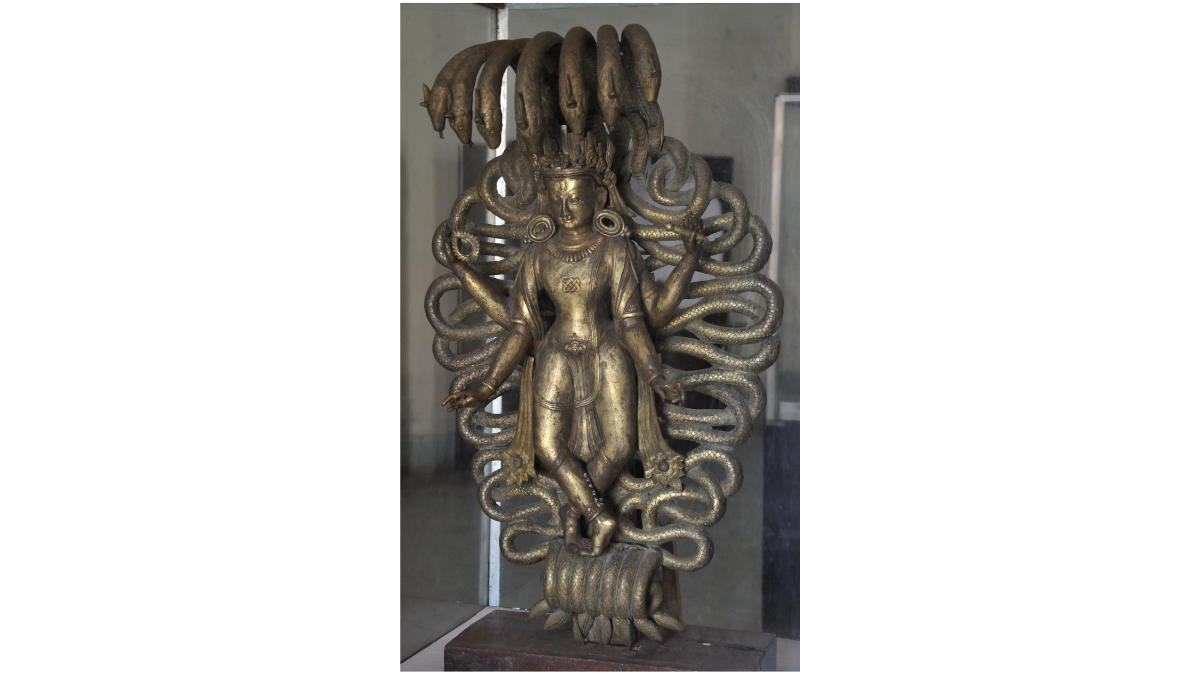In the heart of ancient Indian epics, weaving through tales spun from the loom of time itself, resides Shesha, the thousand-hooded serpent, a deity of magnificent scale and deep cosmic resonance. As the couch of Lord Vishnu, the preserver in the Hindu triad of deities, and the bearer of all the planets on his hoods, Shesha emerges as a cornerstone in the architectural ensemble of Hindu mythology. Its name, translating to “That which remains,” hints at its role as the eternal, cosmic serpent, embodying the essence of time, stability, and divine support, providing a robust base to the ever-churning cosmos.
Draped in scales of iridescent blues and greens that mirror the depths of oceanic abysses, Shesha unfurls across the heavenly realms with a grandeur that is at once beautiful and terrifying. In the Puranas, it is described as having a thousand heads adorned with crowns embedded with glittering gems, each head casting a luminous glow, enveloping the universe in a soft, golden light. This light can be seen as a protective aura, a divine shield holding chaos and darkness at bay, safeguarding the cosmos through myriad yugas or epochs.
With a body that expands and contracts to encompass worlds within its coils, Shesha embodies infinity itself, a being without beginning or end. It is the silent witness to the cyclic dance of creation and destruction, an immortal who resides in the cosmic waters of Ksheer Sagar, resting in a state of divine contemplation, nurturing worlds with a breath that ebbs and flows with the tides of time.
Shesha’s connection with Lord Vishnu is not just foundational but also deeply symbiotic, revealing a profound unity in duality. As Vishnu reclines in a state of cosmic contemplation, Shesha forms his resting place, a divine serpent bed that resonates with the harmonies of the universe, a celestial symbiosis that speaks of deep trust and the interconnectedness of all life forces. In this symbiotic dance, Vishnu’s dreams take form, birthed from the cosmic rhythms that echo through Shesha’s thousand hoods, a concert of divine energies manifesting as reverberating echoes through the corridors of time and space.
Artists and sculptors who venture to portray Shesha do so with reverence and awe, invoking the serpent’s magnificence through intricate details that capture its grandeur and serenity. The serpent rises, a mountain of hoods poised gracefully, a complex tapestry of scales, eyes, and fangs that represent an order within the chaos, a cosmos within the anarchy, echoing the intricate dance of reality, where everything exists in relation to everything else.
In the shadow of its hoods, sage Patanjali, believed to be an incarnation of Shesha, gifted humanity the knowledge of yoga, a pathway to harmonizing the human spirit with the cosmic rhythm, a legacy of wisdom interwoven with the serpent’s eternal journey through the spirals of time.
In Indian festivals, particularly during Nag Panchami, Shesha is venerated with deep devotion, a day when the serpent’s guardianship of the earth’s waters and its foundational role in supporting the planets are celebrated with offerings of milk and flowers, a symbiotic ritual connecting humans with the divine through gestures of gratitude and reverence.
Shesha, the thousand-hooded serpent, spirals through the ancient scripts as a being of unparalleled grandeur, a cosmic serpent weaving tales of eternity, a guardian of worlds, a symbol of the infinite potential that exists when stability and creativity dance in harmony, holding the fabric of the universe in a steady, yet ever-evolving embrace, reverberating with the silent song of the cosmos, resounding through time, singing the story of all that was, is, and ever will be.








